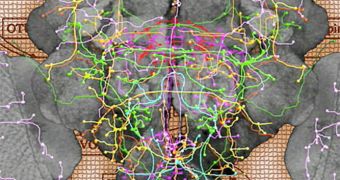A group of scientists announces the development of a new computer model that is capable of producing a type of science never before thought possible. The team plans to create maps of the fruit fly brain one cell at a time, in a bid to produce the first map of how neurons interact in their cortex. The end goal is to determine how the neurons on the insect work together to perform even the simplest tasks. In order for this to become possible, the investigators first need to create networks of how the cells work together, in a research that could provide a powerful new tool for future investigations of the human brain as well, Wired reports.
According to scientists, there are about 100,000 neurons in the brain of a single fruit fly. Our cortices feature no less than 100 billion neurons, and so having a well-established starting point in mapping them could prove to be useful. At this point, one of the main obstacles in producing maps of how our own nerve cells interact is the fact that their synapses are simply too complex to handle. Each single neuron can connect to thousands of others, and stretch its axon for a few centimeters in the brain. Therefore, if the new work on the fruit fly is successful, experts could at least benefit from a clear starting point in their laborious work.
What the experts behind the new work are striving for is creating a “master plan” of the fruit fly brain. “We can see very beautiful and very complicated patterns. If you look at neurons at a better resolution, or look at regions you’ve never looked at before, you’ll find something new,” says Howard Hughes Medical Institute Janelia Farm Research Campus expert Hanchuan Peng. He presented the new model at the 51st Annual Drosophila Research Conference, on April 9. Details of the work also appear in a paper published in the April issue of the respected scientific journal Nature Biotechnology.
“What we want to do in the next few years is to add more and more neuron reconstructions into this map. If you think about the fruit fly brain as the Earth, the little neurons will be the streets. We want to map a lot of neuron streets onto the Earth,” adds Peng, who is also a coauthor of the new journal entry. One of the main discoveries the team has made thus far was observing that particular sets of neurons, which at first glance seemed to be faithful copies of each other, exhibit importance functional differences.

 14 DAY TRIAL //
14 DAY TRIAL //